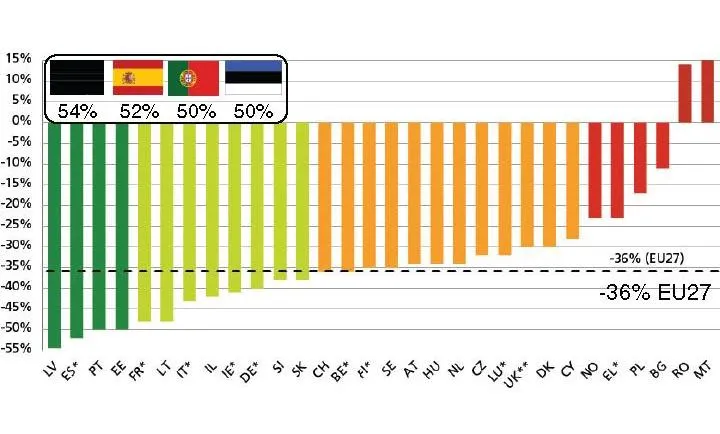A wide variety of road safety measures are being implemented across Europe, and with generally beneficial effects. According to the latest data from the European Commission, road fatalities across the EU dropped 9% for 2012 compared with the previous year. In fact 2012 also saw the lowest numbers of people being killed in road traffic crashes in EU countries since data first began being collated. But country by country statistics show that the number of road deaths still varies greatly across the EU.
May 24, 2013
Read time: 3 mins

A wide variety of road safety measures are being implemented across Europe, and with generally beneficial effects. According to the latest data from the European Commission, road fatalities across the EU dropped 9% for 2012 compared with the previous year. In fact 2012 also saw the lowest numbers of people being killed in road traffic crashes in EU countries since data first began being collated. But country by country statistics show that the number of road deaths still varies greatly across the EU. The countries with the lowest number of road fatalities remain the UK, Sweden, the Netherlands and Denmark, reporting around 30 deaths/million inhabitants. From Italy comes information showing a steady decline in the road casualty figures. In 2011 there were 3,860 road crash fatalities in Italy, a notable drop from the 5,131 deaths recorded in 2007. Between 2007 and 2011, there were 22,043 people killed on Italy’s roads in total. Meanwhile the number of injuries also dropped 17.1%. The number of road traffic deaths has fallen consistently in Italy: by 5% in 2011, 8.2% in 2010, 9.5% in 2009 and 10.4% in 2008.
Compared to the disappointing figures of 2011, when progress in cutting road deaths fell to 2%, the reduction of 9% in 2012 means the European nations are back on track towards the objective of halving road deaths between 2010 and 2020. In order to reach this goal, an average reduction of around 7% is needed.
The most worrying feature of the road safety statistics for 2011 was a high increase in the number of killed vulnerable users such as pedestrians, motorcyclists and elderly people, in spite of an overall reduction of road fatalities. Based on the provisional data for 2012, the number of vulnerable user fatalities has decreased substantially in 2012.
The news that the crash rate and fatality levels have fallen is certainly good. But a major problem now is to interpret which measures have been most successful. Some countries such as France and Portugal have had success in cutting crashes through tougher enforcement of laws on drink driving and speeding. But in other countries, the reasons for the overall safety gains are less clear. And this is a serious problem.
If the benefits of European road safety measures are to be implemented in other continents where road fatality rates are growing, it would be useful to know which are the most effective. Asia in particular has a spiralling road death rate as vehicle numbers explode. Without fully understanding why Europe is cutting its road deaths, there can be little chance of taking this expertise elsewhere.
Compared to the disappointing figures of 2011, when progress in cutting road deaths fell to 2%, the reduction of 9% in 2012 means the European nations are back on track towards the objective of halving road deaths between 2010 and 2020. In order to reach this goal, an average reduction of around 7% is needed.
The most worrying feature of the road safety statistics for 2011 was a high increase in the number of killed vulnerable users such as pedestrians, motorcyclists and elderly people, in spite of an overall reduction of road fatalities. Based on the provisional data for 2012, the number of vulnerable user fatalities has decreased substantially in 2012.
The news that the crash rate and fatality levels have fallen is certainly good. But a major problem now is to interpret which measures have been most successful. Some countries such as France and Portugal have had success in cutting crashes through tougher enforcement of laws on drink driving and speeding. But in other countries, the reasons for the overall safety gains are less clear. And this is a serious problem.
If the benefits of European road safety measures are to be implemented in other continents where road fatality rates are growing, it would be useful to know which are the most effective. Asia in particular has a spiralling road death rate as vehicle numbers explode. Without fully understanding why Europe is cutting its road deaths, there can be little chance of taking this expertise elsewhere.








